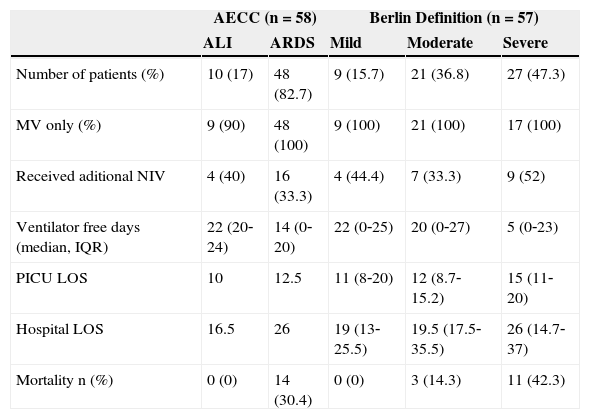It was with great interest and pleasure that we read the Letter to the Editor entitled “International collaborative research for pediatric and neonatal lung injury: the example of an ESPNIC initiative to validate definitions and formulate future research questions” by Daniele De Luca et al.1 The authors commented that the European Society for Pediatric and Neonatal Intensive Care (ESPNIC) published the first validation of the acute respiratory distress syndrome (ARDS) Berlin Definition (BD) in early childhood.2 Members of the ESPNIC Respiratory Section performed a retrospective international (Italy, Spain, France, Austria, and the Netherlands) multicenter study including children aged between 30 days and 18 months with ARDS according to the American‐European Consensus Conference (AECC) criteria.3 It elegantly addresses our concerns on the applicability of BD in pediatrics when we described the evolution of ARDS definitions.4
A time lapse between the two publications prevented exact connections between them; now is the opportunity to do so. The BD5 for adults and children is an advance, in the sense that ARDS stratification is important for diagnosis and treatment. However, it was obvious that pediatricians working in clinical or basic research needed to validate the new data in children. The work performed by The Respiratory Section of ESPNIC2 enrolled 221 children, median age 6 months (range 2‐13 months), which were categorized according to the two definitions. The authors found very interesting and important results. Applying AECC, 36 children were classified as ALI and 185 as ARDS, with mortality rates of 13.9% and 17.8%, respectively. Conversely, 36 were classified as mild, 97 as moderate, and 88 as severe ARDS when applying the BD. The BD described the clinical situation better than AECC, with similar results published in adults. Also, the main outcomes were significantly different only for severe ARDS; mortality was 13.9% for mild ARDS, 11.3% for moderate ARDS, and 25% for severe ARDS. They did not find significant differences between mild and moderate classes. However, the inclusion of a severe category in the BD helped to increase its validity. Despite not aimed at identifying risk factors and their association with ARDS, some were presented (sepsis, near‐drowning, congenital immunodeficiencies, thoracic trauma, etc.). As expected, they are different than those in the adult population. A properly designed study is therefore necessary to address this issue. The authors concluded that the new ARDS definition correctly adjusts and is able to define the syndrome in its population, subdividing it into mild/moderate and severe ARDS.
Some limitations were addressed. Firstly, the number of patients included was not large. This is a difficulty in all pediatric studies, as populations of children in intensive care are much smaller than those of adults. Secondly, clinical data was not correlated with lung morphology. However, lung biopsy is not commonly performed in critically ill children.
The Brazilian Pediatric ARDS Study Group6 performed a prospective, multicentre cohort study from March to September of 2013, which aimed: (1) to evaluate the prevalence of ARDS; (2) to determine risk factors for ARDS; and (3) to evaluate whether the use of BD in critically ill children can better discriminate the severity of the disease compared with the AECC definition. The distribution and outcomes of the patients according to the AECC and BD are shown in Table 1.
Distribution and outcomes of the patients according to the American European Consensus Conference (AECC) and the Berlin Definition.
| AECC (n = 58) | Berlin Definition (n = 57) | ||||
|---|---|---|---|---|---|
| ALI | ARDS | Mild | Moderate | Severe | |
| Number of patients (%) | 10 (17) | 48 (82.7) | 9 (15.7) | 21 (36.8) | 27 (47.3) |
| MV only (%) | 9 (90) | 48 (100) | 9 (100) | 21 (100) | 17 (100) |
| Received aditional NIV | 4 (40) | 16 (33.3) | 4 (44.4) | 7 (33.3) | 9 (52) |
| Ventilator free days (median, IQR) | 22 (20‐24) | 14 (0‐20) | 22 (0‐25) | 20 (0‐27) | 5 (0‐23) |
| PICU LOS | 10 | 12.5 | 11 (8‐20) | 12 (8.7‐15.2) | 15 (11‐20) |
| Hospital LOS | 16.5 | 26 | 19 (13‐25.5) | 19.5 (17.5‐35.5) | 26 (14.7‐37) |
| Mortality n (%) | 0 (0) | 14 (30.4) | 0 (0) | 3 (14.3) | 11 (42.3) |
ALI, acute lung injury; ARDS, acute respiratory distress syndrome; LOS, length of stay; MV, mechanical ventilation; NIV, noninvasive mechanical ventilation; PICU, pediatric intensive care unit.
The BD better discriminates the severity of ARDS in children when compared to the AECC definition, as shown by the incremental increase in mortality rates and reduced number of ventilation‐free days in patients with severe ARDS.
In summary, we congratulate De Luca et al.2 for their timely study, and thank them for their comments. From now on, the pediatric community involved in critical care and emergency medicine, of which we are members, has specific parameters to compare when studying such a serious disease as ARDS in children. Moreover, we look forward to the authors taking a similar initiative in Latin America and other future projects.
Conflicts of interestThe authors declare no conflicts of interest.
Please cite this article as: Fioretto JR, de Carvalho WB. ARDS definitions in children: one step forward. J Pediatr (Rio J). 2014;90:211–2.











